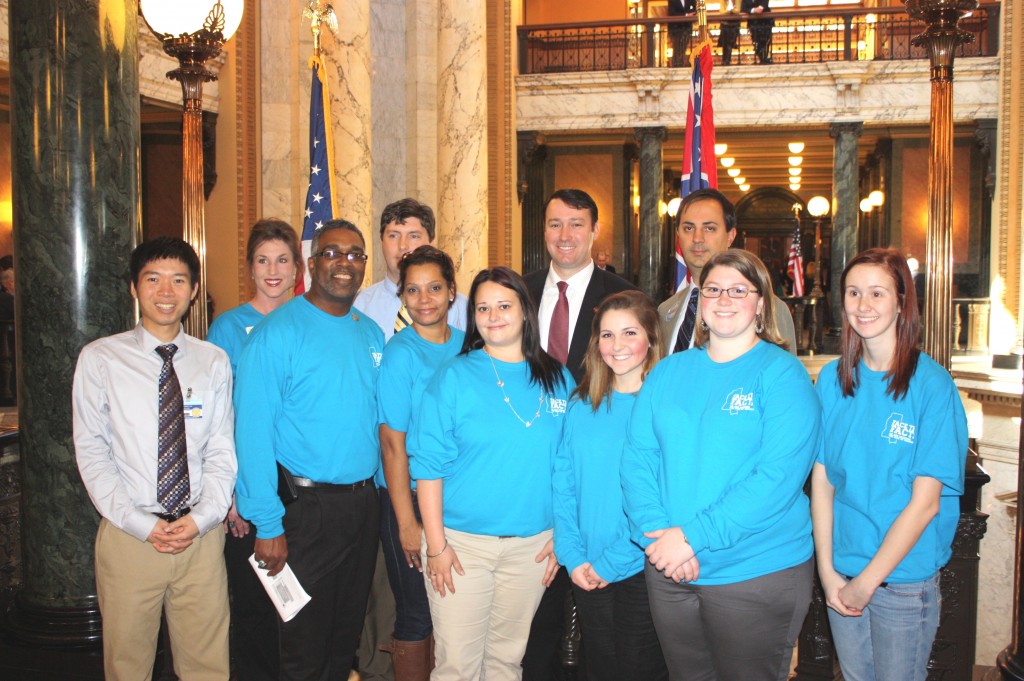
Front row, from left: Dr. Michael Loui, MGCCC biology instructor; and students Marc Leggett, Jennifer Harris, Kacey Hickam, Jordan Reed, Rachel Wolfe and Erin Golladay. Back row, from left: Marsha Cummings, MGCCC Business and Office Technology instructor; Trevor Smith, MGCCC social studies instructor; Senator Sean Tindell, District 49, Harrison County; and Brian Carriere, MGCCC social studies instructor and vice president of the Mississippi Faculty Association for Community and Junior Colleges.
Dozens of Mississippi community college students flooded the Capitol in Jackson on February 28 to ask their legislators to continue their financial support of the 15 colleges.
At a morning news conference, state Senator Terry Burton of Newton told community college supporters that lawmakers appreciate the job the colleges do.
“It’s important for us to know as legislators that the best value in education in Mississippi and, I believe, in the world is the Mississippi community and junior college system. Our continued economic success demands that we provide for you the best funding source that we can from the state. It doesn’t go unnoticed – the accountability, the efficiency and the numbers of people you serve with those funds,” Burton says. “We’re going to do the very best that we can in funding you.”
With 68 percent of all freshmen as their students, Mississippi’s 15 community colleges play a key role in the state’s higher education system that leads to a more educated populace and a trained workforce.
In 2007 legislators promised to fund the colleges at the mid-level point – per-student funding halfway between K-12 education and the regional public universities – but the community colleges are only getting 52 percent of the promised funds. The colleges are seeking to regain the ground they lost since the legislation was passed and funding was only 28 percent below the mid-level target. It will take $73.5 million to make it to that point.
Mid-level funding mandates per-student funding for community colleges that is midway between per-student funding for K-12 students and regional public university students. Using data from FY 2011, the regional public universities were funded at $5,803 per student and public schools were funded at $4,560 per student. Accordingly, community colleges should have been funded at $5,182 per student, but instead received only $2,686 per student.
Dr. Mary Graham, president of Mississippi Gulf Coast Community College, says the colleges appreciate what legislators have done to help.
“We have many friends in the Legislature who understand the role of the community colleges. You are doing a tremendous job of supporting us and we appreciate that,” she says. “We are making a difference in economic development. We are making a difference in the lives of so many people. We are giving hope to the next generation. Student are able to attend the community colleges as a traditional student and as an adult student as a way to get into the workforce.”
Dr. Eric Clark, executive director of the Mississippi Community College Board, said the colleges are life-changers.
“I am absolutely certain that the primary institution at this point in our history which is helping folks get off welfare, get out of minimum wage jobs and stay out of jail is our Mississippi community colleges,” Clark says.
Among the speakers at the Thursday news conference was Brian Carriere, vice president of the 900-member Mississippi Faculty Association for Community and Junior Colleges, which hosts the annual Capitol Day event.
“We know the legislators see the community colleges as important, that they are the linchpin of the higher education in the state of Mississippi,” Carriere says. “We are the greatest bargain in the state of Mississippi. We ask you to reach a little bit deeper in those pockets and help us to help you in the state of Mississippi.”
Student VOICES, a student-led advocacy group that encourages students to be civically engaged, joined faculty members at the Capitol.
Community colleges enroll more than 80,000 students, including 56 percent of all undergraduates and half of all students, including graduate students, taking a credit course.
Since Fiscal Year 2000, community college enrollment has grown 57.4 percent while state support per student has declined by 26.4 percent.
About 80 percent of new jobs being developed in the current economy require college-level learning, and, in Mississippi 58 percent of all undergraduates in public institutions are at a community college.
MGCCC graduates are more likely to be employed in a full-time capacity than non-graduates, with a 94 percent job placement rate among career and technical graduates and a 92 percent licensure pass rate amount first-time test-takers in health care and computer/technical programs. MGCCC graduates can expect better salaries as well, earning nearly 30 percent more during their lifetime than those with just a high school diploma. Students with an associate degree earn almost $4,000 more a year in wages than a high school graduate and $13,000 more than someone with less than a high school education.
MGCCC is ranked in the top 100 for producing graduates out of the 1,200 public two-year community colleges in the country. According to this independent poll, the college ranks 59th in producing associate-degree graduates. This same poll also ranks the college 44th in producing African-American graduates and fourth in the nation for education majors. MGCCC is also the single-largest GED producer in the state, with more than 1,000 GEDs awarded last year.
